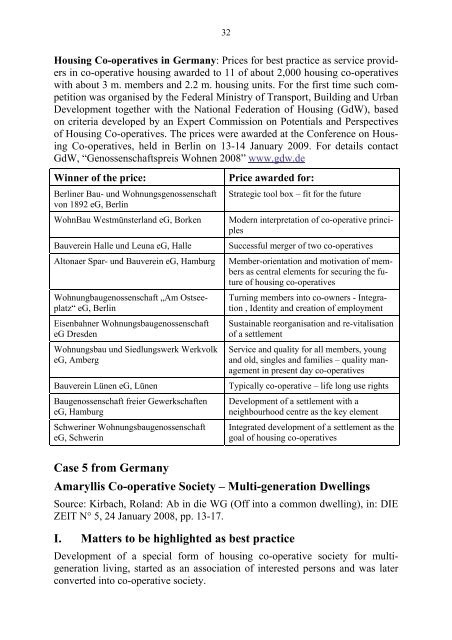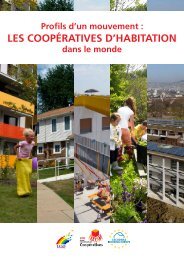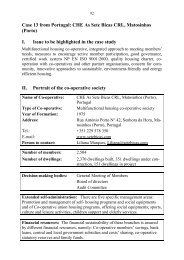Case 5 from Germany Amaryllis Co-operative Society ... - ICA Housing
Case 5 from Germany Amaryllis Co-operative Society ... - ICA Housing
Case 5 from Germany Amaryllis Co-operative Society ... - ICA Housing
Create successful ePaper yourself
Turn your PDF publications into a flip-book with our unique Google optimized e-Paper software.
32<br />
<strong>Housing</strong> <strong>Co</strong>-<strong>operative</strong>s in <strong>Germany</strong>: Prices for best practice as service providers<br />
in co-<strong>operative</strong> housing awarded to 11 of about 2,000 housing co-<strong>operative</strong>s<br />
with about 3 m. members and 2.2 m. housing units. For the first time such competition<br />
was organised by the Federal Ministry of Transport, Building and Urban<br />
Development together with the National Federation of <strong>Housing</strong> (GdW), based<br />
on criteria developed by an Expert <strong>Co</strong>mmission on Potentials and Perspectives<br />
of <strong>Housing</strong> <strong>Co</strong>-<strong>operative</strong>s. The prices were awarded at the <strong>Co</strong>nference on <strong>Housing</strong><br />
<strong>Co</strong>-<strong>operative</strong>s, held in Berlin on 13-14 January 2009. For details contact<br />
GdW, “Genossenschaftspreis Wohnen 2008” www.gdw.de<br />
Winner of the price: Price awarded for:<br />
Berliner Bau- und Wohnungsgenossenschaft<br />
von 1892 eG, Berlin<br />
Strategic tool box – fit for the future<br />
WohnBau Westmünsterland eG, Borken Modern interpretation of co-<strong>operative</strong> principles<br />
Bauverein Halle und Leuna eG, Halle Successful merger of two co-<strong>operative</strong>s<br />
Altonaer Spar- und Bauverein eG, Hamburg Member-orientation and motivation of members<br />
as central elements for securing the future<br />
of housing co-<strong>operative</strong>s<br />
Wohnungbaugenossenschaft „Am Ostseeplatz“<br />
eG, Berlin<br />
Eisenbahner Wohnungsbaugenossenschaft<br />
eG Dresden<br />
Wohnungsbau und Siedlungswerk Werkvolk<br />
eG, Amberg<br />
Turning members into co-owners - Integration<br />
, Identity and creation of employment<br />
Sustainable reorganisation and re-vitalisation<br />
of a settlement<br />
Service and quality for all members, young<br />
and old, singles and families – quality management<br />
in present day co-<strong>operative</strong>s<br />
Bauverein Lünen eG, Lünen Typically co-<strong>operative</strong> – life long use rights<br />
Baugenossenschaft freier Gewerkschaften<br />
eG, Hamburg<br />
Schweriner Wohnungsbaugenossenschaft<br />
eG, Schwerin<br />
Development of a settlement with a<br />
neighbourhood centre as the key element<br />
Integrated development of a settlement as the<br />
goal of housing co-<strong>operative</strong>s<br />
<strong>Case</strong> 5 <strong>from</strong> <strong>Germany</strong><br />
<strong>Amaryllis</strong> <strong>Co</strong>-<strong>operative</strong> <strong>Society</strong> – Multi-generation Dwellings<br />
Source: Kirbach, Roland: Ab in die WG (Off into a common dwelling), in: DIE<br />
ZEIT N° 5, 24 January 2008, pp. 13-17.<br />
I. Matters to be highlighted as best practice<br />
Development of a special form of housing co-<strong>operative</strong> society for multigeneration<br />
living, started as an association of interested persons and was later<br />
converted into co-<strong>operative</strong> society.
33<br />
Successful combination of self-interest and group interest in a co-<strong>operative</strong> society.<br />
Limits of open membership in a close housing community.<br />
II. Portrait of the co-<strong>operative</strong> society<br />
Name of <strong>Co</strong>-<strong>operative</strong>: <strong>Amaryllis</strong> eG<br />
Type of <strong>Co</strong>-<strong>operative</strong>: <strong>Housing</strong> <strong>Co</strong>-<strong>operative</strong> <strong>Society</strong> at primary society<br />
level, Multi-generation housing project (Wohnungsgenossenschaft<br />
− Mehrgenerationen-<br />
Wohnprojekt)<br />
Year of Formation: <strong>Amaryllis</strong> co-<strong>operative</strong> society (eG) 2005<br />
formed by conversion of the <strong>Amaryllis</strong> association<br />
(e.V.) founded in 1992<br />
Address: Wiesenpfad 18, D – 53757 Sankt Augustin<br />
Tel.: Tel.: +49 (0) 228 555 25 986<br />
E-mail: www.amaryllis-bonn.de<br />
Person to contact: Silke Gross, Dorothea-Erxleben-Weg 8, 53229<br />
Bonn<br />
Number of members: 46 adults aged between 26 and 85 and 20 children<br />
and young persons of less than 18 years.<br />
Number of dwellings: 32 Apartments, 26 of which financed privately<br />
and 6 under social housing programme plus one<br />
large apartment for collective living of 6 persons.<br />
Decision-making bodies: General Meeting (one member – one vote)<br />
Board of directors<br />
Supervisory committee<br />
Extended self-administration: Every inhabitant has a defined task in the co<strong>operative</strong><br />
society. Each contributes according to<br />
his/her talents and capabilities to reaching the<br />
aims of the co-<strong>operative</strong> society as an enterprise<br />
and as a group of persons.<br />
Weekly plenary meetings of all inhabitants<br />
Sources of finance:<br />
Each member has to sign at least one share of € 5,000 plus about 15 percent of<br />
the total cost of the apartment (i.e. some € 300 per m 2 ). There is no additional
liability of the member for debts of the co-<strong>operative</strong> society. Additional shares<br />
may be signed up to a total of € 50,000.<br />
34<br />
To increase the creditworthiness of the co-<strong>operative</strong> society vis-à-vis external<br />
investors, external sponsors were sought to serve as guarantors. A special fund<br />
created <strong>from</strong> contributions of members who are financially better off, issues<br />
loans to financially weaker members to help them pay-up their shares.<br />
Deposits and guarantees are administered in collaboration with a co-<strong>operative</strong><br />
bank.<br />
Affiliation to federations<br />
and other organisations:<br />
• From 2005: Affiliation to a co-<strong>operative</strong> auditing federation,<br />
• <strong>Co</strong>llaboration with a housing consultancy firm (WohnBund Beratung GmbH,<br />
Nordrhein Westfalen, NRW) for advice on acquisition of land, financial<br />
planning and drafting the by-laws of the co-<strong>operative</strong> society,<br />
• Agreements of co-operation with the competent authorities of the City of<br />
Bonn, the Federal State of NRW and a firm of architects.<br />
III. Description of the case<br />
Background information on aging Germans<br />
In <strong>Germany</strong>, every year the number of persons above the age of 65 grows by<br />
500,000. Between 2003 and 2006 it has grown <strong>from</strong> 14.9 million to 16.3 million.<br />
The total of persons needing care has increased between 1991 and 2002 <strong>from</strong> 1.6<br />
million to over 2 million and will reach 2.8 million by 2020.<br />
This means for all elderly persons who have no relatives to stay with and who<br />
would provide care that they will depend on stationary care. The family networks<br />
are becoming weaker. The distance between parents and their adult children<br />
is growing with decreasing contacts (as shown in a study presented by the<br />
German Federal Government on elderly citizens). This leaves the old with the<br />
choice between loneliness and stationary care.<br />
Preferences and options of elderly persons regarding their forms of living<br />
A survey carried out in <strong>Germany</strong> by the German Federal Government shows that<br />
only 6 percent of elderly persons would like to live in a common dwelling, while<br />
19 percent would consider this as a possibility. The figures for other forms of<br />
living are as follows:<br />
Form of living Preference Possible option<br />
Residential care 9 % 35 %
Staying with children 25 % 30 %<br />
Senior citizens residence 44 % 24 %<br />
Rearrange current dwelling 34 % 41 %<br />
35<br />
The search is on for new forms of joint dwellings like multi-generation dwellings<br />
preferred in comparison with the classical model of shared flats with a<br />
common kitchen and bathroom. The demand for multi-generation housing is<br />
growing (between 2005 and 2006 by 50 percent). Today, most elderly people do<br />
not want to be taken to senior citizen residences with stationary care. They want<br />
to live in a community, see what happens outside, communicate with others and<br />
visit one another. The problem is to find the right social distance between<br />
neighbours. Professional advice in this regard may be beneficial.<br />
The attitude of persons living in such multi-generation settlements should be:<br />
“We do not live here to help others, but we do so to meet our own needs”.<br />
In such housing projects, the question of ownership is important. Individual<br />
ownership of dwellings encourages egoism. Planning for flexibility is equally<br />
important. Flats have to be built in such a way that one large flat can be converted<br />
into two small flats plus guest apartment. Such designs have been developed<br />
by architects specialized in designing multi-generation houses for heterogeneous<br />
groups of inhabitants, e.g. an old villa can be subdivided into 11 tworoom<br />
apartments plus 300 m 2 of common space. In this case, 11 ladies aged between<br />
69 and 85 years live in a self-organised housing community. The old villa<br />
was offered by the city government to be used free of charge for a period of 25<br />
years, provided that the cost of renovation (€ 1 million) were covered by the inhabitants.<br />
A loan taken for this purpose by the residents is paid back by a supplement<br />
to the monthly rent.<br />
Need to make a choice in time<br />
For elderly people living in their old large flats or houses, the moment comes<br />
when these flats become too large and living becomes too lonely. When moving<br />
into smaller flats this means to leave the well known environment and most of<br />
the old furniture behind, one had for the past decades.<br />
The <strong>Amaryllis</strong> project<br />
The leading idea of Amarillys is: When getting old one should not live alone, but<br />
rather together with others. This can be achieved by moving into a multigeneration-project.<br />
The first step was to join an association of persons with similar needs – the<br />
<strong>Amaryllis</strong> Association, formed by three couples in Bonn in the 1990s. The object<br />
of this association was to allow old and young persons with and without
36<br />
children to live under one roof. When launching the idea, more applications to<br />
join were received than could be accepted.<br />
More than a decade later, the association was converted into a co-<strong>operative</strong> society<br />
and started to build multi-generation dwellings in form of three two-story<br />
houses for a total of 66 inhabitants including 20 children.<br />
The aim of the <strong>Amaryllis</strong> co-<strong>operative</strong> society is to offer its members a form of<br />
living together that reaches beyond generations and allows persons of all ages to<br />
live together. Dwellings without barriers are combined with modern ecological<br />
standards of saving energy (central heating with wood pellets, car-sharing).<br />
A special design of the houses helps to generate good relations with neighbours.<br />
In the first floor, doors <strong>from</strong> the living rooms lead to a balcony around the entire<br />
house linking all flats. In the ground floor, flats are linked by a common terrace.<br />
In this way the distance between neighbours is kept small.<br />
The new settlement is perceived as a kind of village, allowing communication<br />
across generation limits, encouraging to help others and to be helped in case of<br />
need. This is seen as an alternative to stationary care in a senior citizens residence,<br />
where old persons are locked up and kept away <strong>from</strong> normal social contacts.<br />
It meets the desire of old persons to be able to continue to live in their own<br />
flat even in case of sickness and need of care. The idea is to allow selfdetermined<br />
living as long as possible.<br />
Members of the <strong>Amaryllis</strong> co-<strong>operative</strong> society work in the organisation on an<br />
honorary basis. Every member holds an office in the co-<strong>operative</strong> society. They<br />
plan the new houses and administer the community together. E.g. every Tuesday<br />
there is a plenary meeting of all inhabitants in which attendance is compulsory.<br />
These meetings are used to spread information, to find solutions for common<br />
problems and to settle disputes.<br />
There is no need to do everything together. Each inhabitant can withdraw into<br />
his/her own flat. However, there is the chance to do many things together. The<br />
co-<strong>operative</strong> serves as a net which supports and empowers the individual. Such<br />
organisation cannot be composed only of old people needing help. Membership<br />
has to be a mix of young and old persons. It has to be a multi-generation project.<br />
In the case of the <strong>Amaryllis</strong> co-<strong>operative</strong> society it was decided to build new<br />
houses financed by a loan <strong>from</strong> a co-<strong>operative</strong> bank rather than looking for old<br />
houses. To provide collateral security, the members had to find guarantors for<br />
part of the loan among relatives and friends.<br />
The principal motto of the co-<strong>operative</strong> society is: To be interested to live in a<br />
community based on binding rules.<br />
This includes:<br />
• Joint planning of the rules for the new social order of living together,<br />
• Be prepared for mutual aid in day-to-day living,
37<br />
• Adopt an ecologically reasonable life-style, e.g. limiting the number of<br />
cars and parking lots, encouraging car-sharing,<br />
• No individual ownership of flats but rather common ownership together<br />
with a generation contract reaching beyond the present generation. Members<br />
of the original association had formed a co-<strong>operative</strong> society which<br />
becomes the owner of the three houses.<br />
Members have to contribute € 400 per m 2 of space, i.e. for a flat of 50 m 2 a total<br />
of € 20,000. This contribution covers only one fifth of the construction cost. Better<br />
off members of the co-<strong>operative</strong> established a social fund to help those unable<br />
to pay the required share contribution. Some flats are promoted by government<br />
as ‘social housing’ with prices of € 4.80 per m 2 – cold rent – as compared<br />
to € 8.20 per m 2 in case of privately financed flats.<br />
It turned out to be difficult to raise the necessary capital <strong>from</strong> financial service<br />
providers, because:<br />
• The co-<strong>operative</strong> society has a variable share capital with partly voluntary<br />
share contributions,<br />
• no personal liability of the members for the debts of the co-<strong>operative</strong> society,<br />
• difficulties anticipated in case of selling the assets of the co-<strong>operative</strong> society<br />
in case of liquidation.<br />
IV. Best Practice in applying co-<strong>operative</strong> principles<br />
Limits of open membership<br />
Where persons with different interests and priorities and of different age live<br />
closely together in multi-generation dwellings, there has to be a strong common<br />
denominator in terms of shared goals and shared organisation culture, to keep<br />
such a group together. The case of <strong>Amaryllis</strong> co-<strong>operative</strong> society shows how<br />
such strong group of members can be formed in a long selection process during<br />
membership in the <strong>Amaryllis</strong> association before it was converted into the <strong>Amaryllis</strong><br />
co-<strong>operative</strong> society. It also illustrates that the closer the group relations<br />
are the narrower are the limits of open membership.<br />
<strong>Co</strong>mbining self-interest and group interest<br />
The multi-generation project is based on many individual interests supplementing<br />
each other. It allows for instance old couples who have no children of their<br />
own to live with children, while working mothers or parents receive help <strong>from</strong><br />
the elderly by offering child care. E.g. once a week there is a “grandmother day”,<br />
where the child spends an afternoon with its new “grandparents”. Such solution<br />
benefits both and keeps people in good contact as neighbours.





